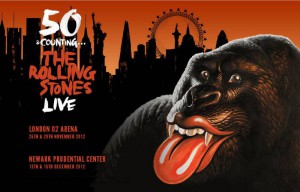 To celebrate fifty years of his career, between late 2012 and early 2013, the Rolling Stones have restarted an organizational machine worthy of better times.
To celebrate fifty years of his career, between late 2012 and early 2013, the Rolling Stones have restarted an organizational machine worthy of better times.
They released “Grrr”, a greatest hits album that is the sum of the compositions of the Glimmer Twins (aka Jagger and Richards), containing two new songs and, depending on the version, fifty to eighty tracks, plus various bonuses such as, for example, records from Ep Vinyl; “Crossfire Hurricane,” the documentary that celebrates the history of the group, the dvd Live in Chicago in 1981 with Muddy Waters and the book “The Rolling Stones 50″, a photographic biography composed of much unpublished material (in Italy was released by Rizzoli). In London was inaugurated the exhibition “Brown sugar on Main Street: unseen images of the Rolling Stones.” The only two concerts – in London and New York – arranged for fifty years have been sold out and have been inhabited many of the stars on stage to celebrate the great British rock band: from Springsteen Clapton, from Lady Gaga to the Black Keys, from Wyman to Tylor (the two former group).
The history and the presence on the scene of the Rolling Stones drives us, in a sense, to redefine the very category of rock’n’roll and, in general, light music (as we call it).
It is the beginning of a new break with a now traditional perception and traditionalized?
If so, it is perhaps worth getting carried away by the idea. And try to develop it in these lines.
Today, the Rolling Stones are the only survivors of the pioneering rock of the sixties: active, fit, full of desire and still adhere, despite fifty years more, the shape and the mythology of rock star perfect. Indeed imperfect, contradictory. Borderline.
And just today their imperfection makes us stretch your neck and measure the reverb that the phenomenon in terms of aesthetics as well as musical. At seventy, in fact, the Stones not only continue to integrate with recognizable signs, the phrase book of pop music, but also help to redefine an iconography that rancid traditionally celebrated only the great musicians of the past (preferably died young and in full oestrus and irreverence).
In this new framework, we can read the rock’n’roll as a popular phenomenon in evolution, not only as the carrier of a revolution. The parable that has come down to us back to the simian mouth and body-whip Jagger, Charlie Watts of the Gretsch (a jazz musician who plays with one tom from the beginning but with a unique technique – lame, stopped and irrepressible – which led to the band’s sound) and, finally, at the hands of Keith Richards, swollen and deformed (like those of many popular musicians photographed by ethnomusicologists).
And if the common opinion is permeated reductive assessment that fits the genre (with little attention to its subgenres and joints) in the categories of immaturity and recklessness, in the eyes of many rock and roll has matured and is no longer only the heat required to change or alternative to the establishment. This paradigm was wearing on the society and culture of the sixties. Today the music that appeared incomprehensible to the old (and some young) then – and that left them suspended in an elapsed time forever and gagged inside a code almost incomprehensible – it has more followers than any other genre of music and has developed solutions without earlier, both musically and costume.
And still new layers overlap the nerve that had shaken the pioneers: the music, which by definition seemed destined to a delirious and eternal youth is mature, but the innovators keep popping up with interesting combinations, because the raw material is more ductile and you can work.
As stated by Mick Jagger, at our age we can still afford to live up to two of the totemic principles of life on the road, and that is the sex and rock’n’roll. We leave clear the drug, but for how much you miss something in poetry and decadence, we are more than satisfied and above all able to balance.
Questo post è disponibile anche in: Italian

 English
English Italiano
Italiano 





Leave a comment
You must be logged in to post a comment.